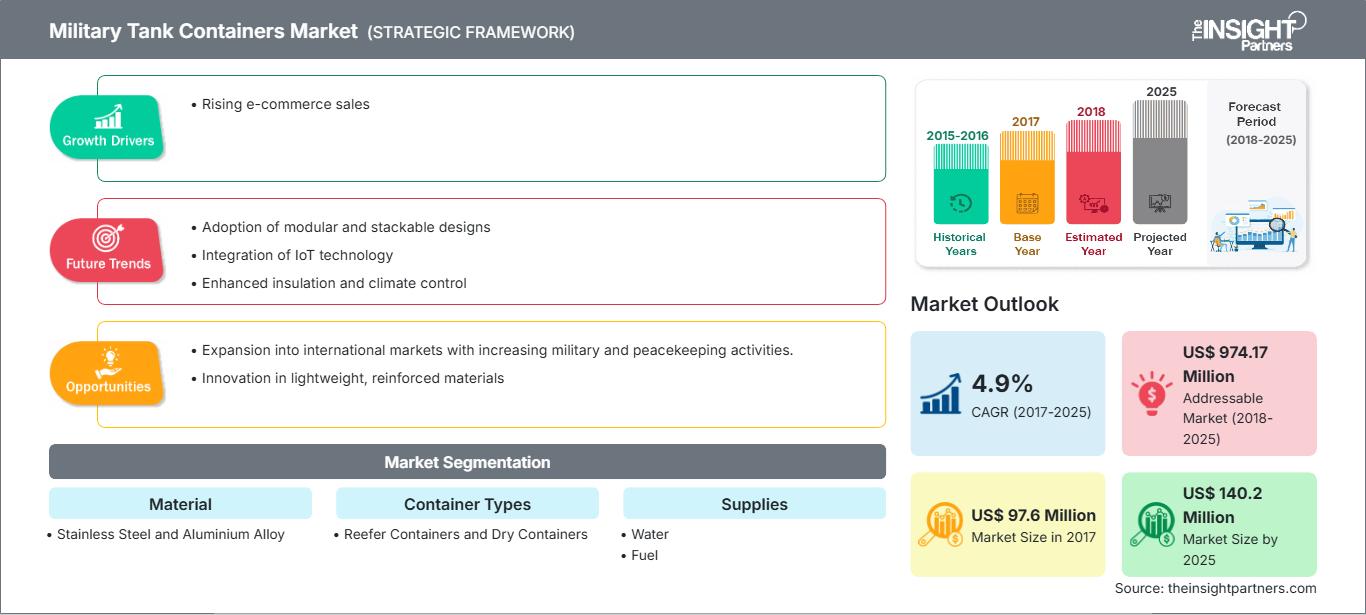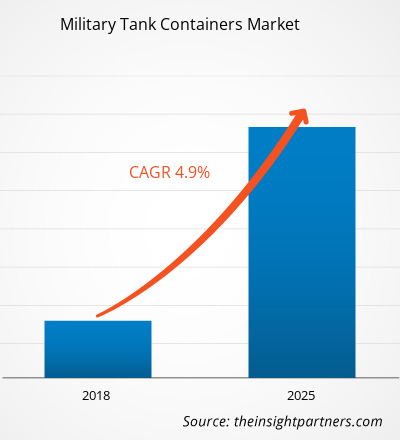In terms of revenue, the global military tank container market was valued at US$ 97.6 million in 2017 and is projected to reach US$ 140.2 million by 2025.
The military tank container market is broadly segmented into five major regions—North America, Europe, APAC, MEA, and SAM. The most prominent region in the current market scenario stands for North America owing to the rapid deployment of troops by the US defense forces. The US Department of Defense (DoD) is constantly posting its troops in countries such as Afghanistan, Syria, Iraq, South Korea, Kuwait and Italy among others in order to deter different threats and maintain sustainable atmosphere. The deployment of large numbers of troops across the globe has led the country to invest significant amounts in the development as well procurement of military tank containers to transport essential commodities to the isolated troops. In addition, Canada on the other hand is also strengthening its logistic facility with these tank containers as the Canadian army is also deploying forces for peace keeping mission. The market for military tank containers is foreseen to witness an expeditionary growth in Asia Pacific region, pertaining to the huge demand for such containerization among defense forces especially Chinese, South Korean and Indian army. The rise in terrorist attacks and other political and warring activities in the above mentioned countries is leading the defense forces to deploy troops along the borders as well as in remote locations. The increasing number of troop deployment from these countries is anticipated to be reason behind the growth of military tank containers market in Asia Pacific region during the forecast period.
Customize This Report To Suit Your Requirement
You will get customization on any report - free of charge - including parts of this report, or country-level analysis, Excel Data pack, as well as avail great offers and discounts for start-ups & universities
Military Tank Containers Market: Strategic Insights

-
Get Top Key Market Trends of this report.This FREE sample will include data analysis, ranging from market trends to estimates and forecasts.
Market Insights–Military Tank Container Market
Growing Deployments of Troops in Peacekeeping Missions Globally by Major Countries of the World
The US is the most powerful nation in the world in terms of the army troop deployments globally. According to US DoD, in 2016 the country spent close to US$ 596 Bn on defense and other related activities. In a recent development proposed by the US Government, there was an announcement of 10% increase in the budget for expenditure on the army troops for the DoD. The expenditure by the country on defense related activities is such that it is more than the next seven countries combined expenditures. Accordingly, the country has deployed approximately 2 lakh troops globally in close to 177 countries of the world. Out of the entire defense budget close to 35% of the share is allocated for the territorial military troops. Domestically, 1.1 Mn active troops are stationed while the rest have been deployed in countries like Afghanistan, Syria, Iraq, Germany, Egypt, South Korea, Kuwait and Italy. The tense political situation in the Middle East has resulted in the larger troops of the army being deployed in those countries for longer times. The troops are usually deployed at strategic locations in such cases to gain competitive advantage and these locations usually face water scarcity. The demand for optimal supply of water and fuel at such locations for efficient operations has been growing and thereby driving the demands for military tank containers.
Type Segment Insights
Based on type, the dry container segment dominated the global military tank container market in 2017. The advantages of an ISO dry tank container are reliability, cost-effectiveness and the safety measure achieved in transportation of bulk liquid to the remotest and inaccessible locations. As these tank containers are designed to meet specific standards and are therefore able to withstand extreme pressure and rough climatic conditions.
Material Segment Insights
Based on material, the stainless steel segment dominated the global military tank container market in 2017. Stainless steel tank containers are durable and low maintenance products that can last for a long period of time once manufactured and put to repeated use. Moreover, the hygienic properties of stainless steel make it an ideal choice for transportation of water, perishable food products and pharmaceuticals.
Supplies Segment Insights
Based on supplies, the fuel segment held the largest share in global military tank container market in 2017. The advantages of an ISO dry tank container are reliability, cost-effectiveness and the safety measure achieved in transportation of bulk liquid to the remotest and inaccessible locations. As these tank containers are designed to meet specific standards and are therefore able to withstand extreme pressure and rough climatic conditions.
End User Segment Insights
Based on end user, the homeland security segment held the largest share in global military tank container market in 2017. As a large number of personnel are deployed for peacekeeping missions, the frequency of usage of military tank containers for provisioning water, fuel, gases and food products and pharmaceuticals is also high that would be driving the demands by this end-user during the forecast period.
The market players focus on new product innovations and developments by integrating advanced technologies and features in their products to compete with the competitors.
- In 2018, Krampitz signed an agreement with Norwegian Government to deliver and install an above ground gas station in the mobile containers. This agreement helped the company to establish its footprints in Norway, thereby increasing its customer base.
- In 2017, WEW Container Systems has signed an agreement with US Army to deliver additional Camel low-profile water tank. Under this contract WEW deliver 167 tanks to prime contractor Choctaw Defense for integration into the Camel II Unit Water Pod System. As per the contract, WEW Container Systems GmbH was supposed to deliver 167 camel low profile water tanks, out of which the company has partially fulfilled the requirements.
- In 2017, WEW launched integrated logistics services to support of tank container system. The company had updated its support services in order to bear the rigidities of multi-modal transport and storage in extremely harsh environmental conditions.
The regional trends and factors influencing the Military Tank Containers Market throughout the forecast period have been thoroughly explained by the analysts at The Insight Partners. This section also discusses Military Tank Containers Market segments and geography across North America, Europe, Asia Pacific, Middle East and Africa, and South and Central America.
Military Tank Containers Market Report Scope
| Report Attribute | Details |
|---|---|
| Market size in 2017 | US$ 97.6 Million |
| Market Size by 2025 | US$ 140.2 Million |
| Global CAGR (2017 - 2025) | 4.9% |
| Historical Data | 2015-2016 |
| Forecast period | 2018-2025 |
| Segments Covered |
By Material
|
| Regions and Countries Covered |
North America
|
| Market leaders and key company profiles |
|
Military Tank Containers Market Players Density: Understanding Its Impact on Business Dynamics
The Military Tank Containers Market is growing rapidly, driven by increasing end-user demand due to factors such as evolving consumer preferences, technological advancements, and greater awareness of the product's benefits. As demand rises, businesses are expanding their offerings, innovating to meet consumer needs, and capitalizing on emerging trends, which further fuels market growth.

- Get the Military Tank Containers Market top key players overview
The global military tank container market has been segmented as follows:
Military Tank Container Market – By Type
- Stainless Steel
- Aluminum Alloy
Military Tank Container Market – By Material
- Reefer Containers
- Dry Containers
Military Tank Container Market – By Supplies
- Water
- Fuel
- Others
Military Tank Container Market – By End User
- Homeland Security
- Military
Military Tank Container Market- By Region
-
North America
- US
- Canada
- Mexico
-
Europe
- France
- Germany
- UK
- Russia
-
Asia Pacific (APAC)
- China
- India
- South Korea
- Japan
- Rest of APAC
-
Middle East and Africa (MEA)
- South Africa
- Saudi Arabia
- UAE
- Rest of MEA
-
South America (SAM)
- Brazil
Military Tank Container Market – Companies Profiles
- WEW Container Systems GmbH
- Krampitz Tanksystems GmbH
- Klinge Corporation
- Seabox, Inc.
- Variel A.S.
- Ancora Sp. Z. O. O.
- AMA Spa
- Eurotainer
- Lava Engineering Company
- Saxon Containers Fze.
- Historical Analysis (2 Years), Base Year, Forecast (7 Years) with CAGR
- PEST and SWOT Analysis
- Market Size Value / Volume - Global, Regional, Country
- Industry and Competitive Landscape
- Excel Dataset
Recent Reports
Related Reports
Testimonials
Reason to Buy
- Informed Decision-Making
- Understanding Market Dynamics
- Competitive Analysis
- Identifying Emerging Markets
- Customer Insights
- Market Forecasts
- Risk Mitigation
- Boosting Operational Efficiency
- Strategic Planning
- Investment Justification
- Tracking Industry Innovations
- Aligning with Regulatory Trends





















 Get Free Sample For
Get Free Sample For